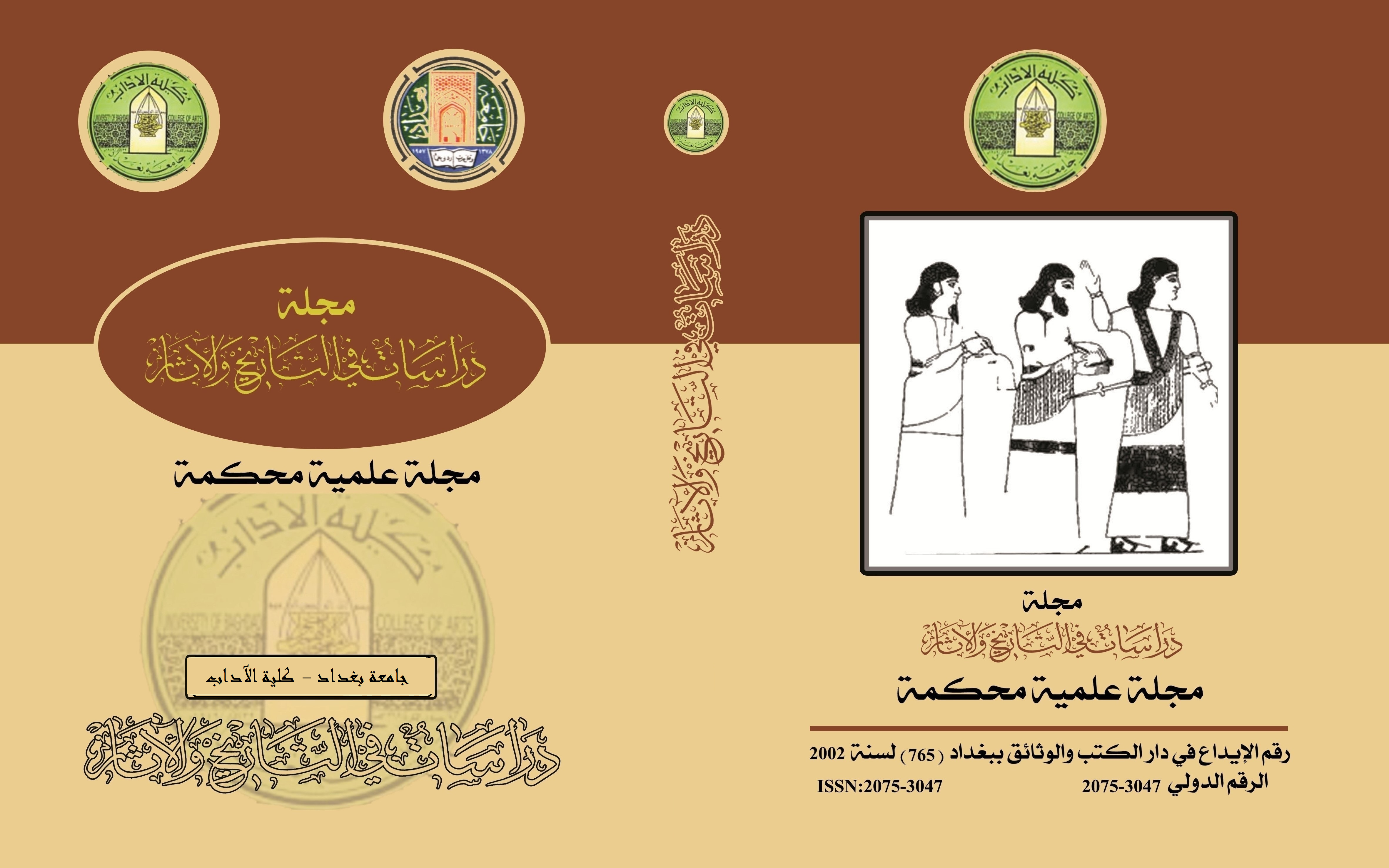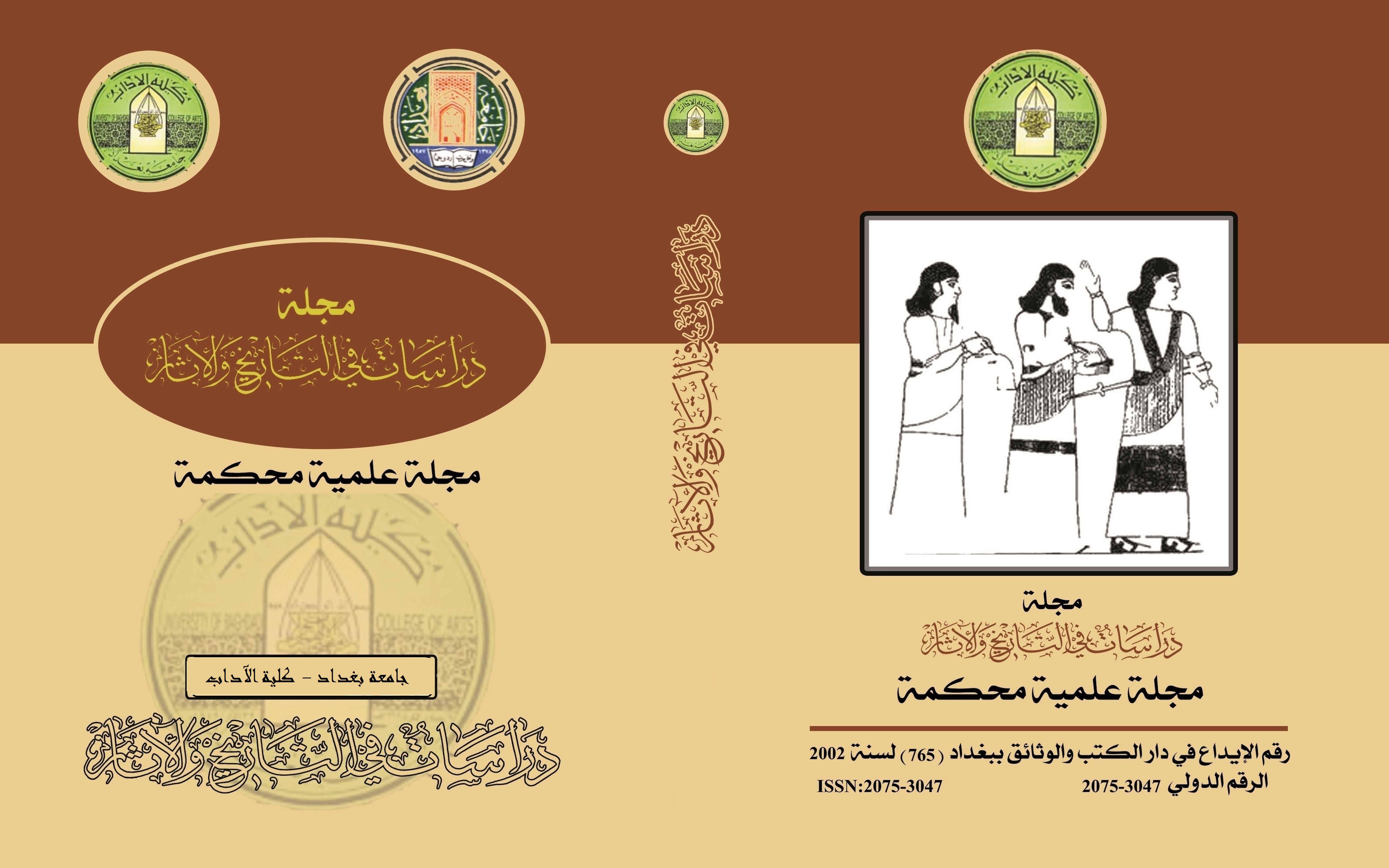البساتين والادب (الاساطير انموذجاً)
الكلمات المفتاحية:
البساتين، الادب، الاساطير، بلاد الرافدين، البستاني، الهة الانوناكي، النماء الزراعي، التنقيبات الاثريةالملخص
يعد الادب واحد من اهم المظاهر الحضارية في بلاد الرافدين، وتاتي اهميته من خلال الجوانب المتعدد له والمضامين المتنوعة التي تناولها والتي ابرز فيها الاديب في حضارة بلاد الرافدين نتاجات رائعة عكست رقي في الفكر والمعتقد، ومن خلال النتاجات المتنوعة لأدب بلاد الرافدين نجده في احيان معينة يلتزم بواقعية الاشياء وامكانية حدوثها اما الشق الاخر منه فقد انطلق به اديب بلاد الرافدين الى سماء الخيال ليعكس لنا تصور وبعد فكري لهذا الاديب، وعلى الرغم من ان الشق الثاني من هذا الادب ياتي في اطار مدلولات خيالية بعيدة عن الواقع الا ان المتلقي لهذا الاداب تعامل معه بواقعية وشمولية ليتاثر بهذا النتاج الادبي الذي يسمو لغايات دينية واجتماعية بحته.
اقترن ادب بلاد الرافدين بالعديد من مفاصل الحياة اليومية ولم يخرج عن هذا الاطار الزراعة بمفهومها الشامل وما يرتبط منها من جزيئات عديدة ياتي في مقدمتها البساتين التي وردت في جوانبه المتعددة ومنها الاساطير والملاحم والحكم والمناظرات وغيرها من الجوانب الادبية.
المراجع
الاسود، حكمت مجيد بشير،(2002): أدب الرثاء في بلاد الرافدين في ضوء المصادر المسمارية، رسالة ماجستير غير منشورة ، جامعة الموصل، كلية الاداب، قسم الاثار.
باقر ، طه ، (1951): نصوص من الأدب العراقي القديم “ ، سومر ، العدد 7 .
باقر، طه ، (1971): ملحمة كلكامش، ط2،،وزارة الثقافة والأعلام ،بغداد.
باقر، طه، (1976): مقدمة في ادب العراق القديم، بغداد.
البياتي، سوسن هادي جعفر،(2004): اساطير العراق القديم-البابلية والسومرية دراسة في شكلها السردي، اطروحة دكتوراه غير منشورة، جامعة تكريت، كلية التربية، قسم اللغة العربية.
جاكوبسن ، ثوركيلد، (2004): اديان ما بين النهرين– إطلالة عامة ، (1987)، بحث ضمن موسوعة :تاريخ الأديان ، ج2، تحرير :فراس السواح ، :دار علاء الدين ، دمشق.
الجبوري، اسماء عبد الكريم،(2014): النخلة في حضارة العراق القديم، بغداد.
جمعة ،احمد بشار،(2011): فكرة الصراع في الأساطير والملاحم العراقية القديمة( 3000 – 2000 ق . م )،رسالة ماجستير غير منشورة ،جامعة واسط، كلية التربية، قسم التاريخ.
الجنابي ،شيماء صلاح احمد،(2007): الاله انكي في حضارة بلاد الرافدين (في ضوء النصوص المسمارية)، رسالة ماجستير غير منشورة ،جامعة بغداد، كلية الاداب، قسم الثار.
الجنابي، كاظم، (1957): مقدمة لدراسة اقدم ادب عرفه الانسان، بغداد.
حنون ، نائل ،(1978): ” شخصية الالهة الام ودور الالهة " انانا - عشتار " في المصادر المسمارية “ ، سومر ، العدد 34 .
الحيالي، فيحاء مولود علي، (2016): الاساطير المنفذة في فنون بلاد الرافدين(دراسة مقارنة)،اطروحة دكتوراه غير منشورة، جامعة بغداد، كلية الاداب، قسم الاثار.
ساكز، هاري، (1979): عظمة بابل، تر: عامر سليمان، الموصل.
سيدا، عبد الباسط، (1995): من الوعي الأسطوري إلى بدايات التفكير الفلسفي النظري (بلاد ما بين النهرين), دار الحصاد للنشر والتوزيع, دمشق.
الشواف، قاسم، (1961): ديوان الاساطير،، أناشيد الحب السومرية ،الكتاب1، ط1 ، بيروت.
الشواف، قاسم، (1999): ديوان الاساطير، سومر واكاد واشور، الحضارة والسلطة، اشراف ادونيس، الكتاب الثالث، بيروت.
علي، فاضل عبد الواحد، (2000): سومر اسطورة وملحمة، بغداد.
فالكشتاين، آدم،(1951): ”ترتيلة اريدو“ تر: محمود الامين، مجلة سومر، مجلد7.
كريمر، صموئيل نوح، (1956): من الواح سومر، تر: طه باقر مراجعة، احمد فخري، بغداد.
كريمر، صموئيل نوح، (1973): السومريون، تر: فيصل الوائلي، الكويت.
كريمر، صموئيل نوح، (1974): أساطير العالم القديم، أساطير سومر وأكاد، ترجمة د. أحمد عبد الحميد يوسف، الهيئة المصرية العامة للكتاب.
كونتينو ، جورج ، (1986): الحياة اليومية في بلاد بابل وآشور ، ط2 ، ترجمة وتعليق سليم طه التكريتي وبرهان عبد التكريتي ، دار الشؤون الثقافية العامة ، بغداد.
مسلان، ميشال، (2009):علم الاديان مساهمة في التاسيس،تر:عز الدين عناية ،ابو ظبي .
موسى، مريم عمران، (1996): الفكر الديني عند السومريين في ضوء المصادر المسمارية، اطروحة دكتوراه غير منشورة، جامعة بغداد، كلية الاداب، قسم الاثار.
يحيى، اسامة عدنان، (2007): الالهة في رؤية الانسان العراقي القديم دراسة في الاساطير، جامعة بغداد، كلية الاداب، قسم التاريخ.
المصادر الاجنبية:
Al-Fouadi, A. (1969): Enki’s Journey to Nippur: The Journeys of the Gods, Ph.D. dissertation, University of Pennsylvania.
Alster, B.,(1977): “ "Ninurta and the Turtle", UET 6/1 2”,JCS,Vol.24, No.4.
Alster, B.,(1978):“Enki and ninhursag:the greation of the first women”,Ugarit-forschungen,Vol.10.
Benite, G., (1969): Enki and Ninmah and Enki and the world Order, London.
Black., J. & Green, A., (1992): Gods. Demons and Symbols of Ancient Mesopotamia, , London.
Dalley, S., (1989): Myths from Mesopotamia, New York.
Dickson,K., (2007): “Enki and ninhursag :the trickster in paradise”, JNES, Vol.66, No,1.
Eidem, J, and Hojlund, F.,(1993): “Trade or diplomacy? Assyrian and dilmun in the eighteenth century BC”, World Archaeology, Vol. 24, No.3.
Espak, P, (2006): Ancient near eastern gods enki and ea, tartu.
Green, M, W., (1975): Eridu in Sumerian literature,Chicago.
Jacobsen, T., (1970): “Sumerian mythology”, Harvard semitic studies,Vol.21.
Jordan, M., (2004): Dictionary of gods and goddesses, second edition, New York.
Kramer , S. N., (1949): “ A Blood - Plague Motifin Sumerian Mythology ”, ArOr,Vol.17 .
Kramer, S. N, and Albright, W.F.,(1945): “Enki and Ninḫursag :A Sumerian “paradise” Myth”, American schools of oriental research,No.1,new haven.
Langdon, M. A, (1923): Historical inscription, containing principally the chronological prism,W-B.444,Oxford.
Leick, G., (1991): A Dictionary of Ancient Near Eastern Mythology, London and New York.
Leisten, B., (2015): Religion and ideology in Assyria, Berlin.
Millard, A.R. ,(1987): “The Sign of the Flood ” ,Iraq, Vol.49.
Nejat, K.R.N., (1998): Daily life in Ancient Mesoptamia, Hendrickson.
Safar, F. and Others, (1981): Eridu, Baghdad.
Sefati, Y, (1981): Love songs in Sumerian literature,Jerusalem.
Tellinger, M., (2012): Slave species of the gods, the secret history of the anunnakki and their mission on earth,USA.
Vanstiphout, H. L. J., (1994): “another attempt at the spell of nudimmud”, Revue d'Assyriologie et d'archéologie orientale, Vol.88, No.2.
Wisnom, S., (2019): Weapons of words: intertextual competition in Babylonian poetry, Brill.
Wisnom, S.,(2019): “Blood on the Wind and the Tablet of Destinies: Intertextuality in Anzû, Enūma eliš, and Erra and Išum”, Journal of the American Oriental Society,Vol.139,No.2.
التنزيلات
منشور
إصدار
القسم
الرخصة

هذا العمل مرخص بموجب Creative Commons Attribution 4.0 International License.
:حقوق الطبع والنشر والترخيص
بالنسبة لجميع البحوث المنشورة في مجلة دراسات في التاريخ والآثار، يحتفظ الباحثون بحقوق النشر. يتم ترخيص البحوث بموجب ترخيص Creative Commons CC BY 4.0 المفتوح ، مما يعني أنه يجوز لأي شخص تنزيل البحث وقراءته مجانًا. بالإضافة إلى ذلك ، يجوز إعادة استخدام البحث واقتباسه شريطة أن يتم الاستشهاد المصدر المنشور الأصلي. تتيح هذه الشروط الاستخدام الأقصى لعمل الباحث وعرضه.
:إعادة إنتاج البحوث المنشورة من الناشرين الآخرين
من الضروري للغاية أن يحصل الباحثون على إذن لإعادة إنتاج أي بحث منشورة (أشكال أو مخططات أو جداول أو أي مقتطفات من نص) لا يدخل في نطاق الملكية العامة أو لا يملكون حقوق نشرها. يجب أن يطلب الباحثون إذنًا من مؤلف حقوق النشر (عادة ما يكون الناشر).
يطلب الإذن في الحالات التالية:
بحوثك الخاصة المنشورة من قِبل ناشرين آخرين ولم تحتفظ بحقوق النشر الخاصة بها.
مقتطفات كبيرة من بحوث أي شخص أو سلسلة من البحوث المنشورة.
استخدم الجداول والرسوم البيانية والمخططات والمخططات والأعمال الفنية إذا لم يتم التعديل عليها.
الصور الفوتوغرافية التي لا تملك حقوق لنشرها.
لا يطلب الإذن في الحالات التالية:
إعادة بناء الجدول الخاص بك مع البيانات المنشورة بالفعل في مكان آخر. يرجى ملاحظة أنه في هذه الحالة يجب عليك ذكر مصدر البيانات في شكل "بيانات من ..." أو "مقتبس من ...".
تعتبر عروض الأسعار القصيرة معقولة الاستخدام العادل ، وبالتالي لا تتطلب إذنًا.
الرسوم البيانية ، الرسوم البيانية ، المخططات ، الأعمال الفنية التي أعاد الباحث رسمها بالكامل والتي تم تغييرها بشكل ملحوظ إلى درجة لا تتطلب الاعتراف.
الحصول على إذن
لتجنب التأخير غير الضروري في عملية النشر ، يجب أن تبدأ في الحصول على أذونات في أقرب وقت ممكن. لا يمكن لمجلة الآداب نشر بحث مقتبس من منشورات أخرى دون إذن.
قد يمنحك مالك حقوق الطبع والنشر تعليمات بشأن شكل الإقرار الواجب اتباعه لتوثيق عمله ؛ بخلاف ذلك ، اتبع النمط: "مستنسخ بإذن من [المؤلف] ، [كتاب / المجلة] ؛ نشره [الناشر] ، [السنة]." في نهاية شرح الجدول ، الشكل أو المخطط.



















